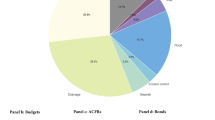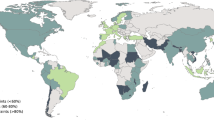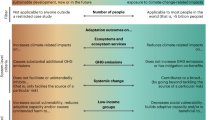Abstract
An adaptation gap exists when adaptation efforts fail to meet adaptation needs. While conceptualizing and operationalizing this gap is challenging, we argue that it should begin with aligning climate risks with policy goals, measures and monitoring and evaluation—what we refer to as ‘consistency’ within adaptation policy. Through a comprehensive European study, we demonstrate how assessing consistency in adaptation plans can enhance understanding and help reduce the adaptation gap.
This is a preview of subscription content, access via your institution
Access options
Access Nature and 54 other Nature Portfolio journals
Get Nature+, our best-value online-access subscription
27,99 € / 30 days
cancel any time
Subscribe to this journal
Receive 12 print issues and online access
209,00 € per year
only 17,42 € per issue
Buy this article
- Purchase on SpringerLink
- Instant access to full article PDF
Prices may be subject to local taxes which are calculated during checkout


Similar content being viewed by others
Data availability
The open-access datasets that support the findings of this study are available at https://doi.org/10.17026/dans-xd6-w7pc (ref. 30).
Change history
04 June 2025
A Correction to this paper has been published: https://doi.org/10.1038/s41558-025-02370-6
References
World Meteorological Organization. State of the Climate in Europe 2022 (WMO, 2023).
IPCC Climate Change 2022: Impacts, Adaptation and Vulnerability (eds Pörtner, H.-O. et al.) (Cambridge Univ. Press, 2022).
Eurostat. Urban-rural Europe (2024).
European Environment Agency. Urban Adaptation in Europe: What Works? EEA Report 14/2023 (2024).
United Nations Environment Programme. Adaptation Gap Report 2023: Underfinanced. Underprepared. Inadequate Investment and Planning on Climate Adaptation Leaves World Exposed(UNEP, 2023); https://doi.org/10.59117/20.500.11822/43796
Garschagen, M. et al. in Climate Change 2022: Impacts, Adaptation and Vulnerability (eds Pörtner, H.-O. et al.) 2539–2654 (IPCC, Cambridge Univ. Press, 2022).
Bulkeley, H. The condition of urban climate experimentation. Sustain.: Sci. Pract. Policy 19, 2188726 (2023).
Chen, C., Doherty, M., Coffee, J., Wong, T. & Hellmann, J. Measuring the adaptation gap: a framework for evaluating climate hazards and opportunities in urban areas. Environ. Sci. Policy 66, 403–419 (2016).
Lu, S. & Nakhmurina, A. Financial constraints and short-term planning are linked to flood risk adaptation gaps in US cities. Commun. Earth Environ. 5, 43 (2024).
Arteaga, E., Nalau, J., Biesbroek, R. & Howes, M. Unpacking the theory-practice gap in climate adaptation. Clim. Risk Manag. 42, 100567 (2023).
Magnan, A. K. et al. Status of global coastal adaptation. Nat. Clim. Change 13, 1213–1221 (2023).
Reckien, D. et al. Quality of urban climate adaptation plans over time. npj Urban. Sustain. 3, 4–6 (2023).
Ford, J. D. & Berrang-Ford, L. The 4Cs of adaptation tracking: consistency, comparability, comprehensiveness, coherency. Mitig. Adapt. Strateg. Glob. Change 21, 839–859 (2016).
Gibbs, M. T. Consistency in coastal climate adaption planning in Australia and the importance of understanding local political barriers to implementation. Ocean Coast. Manag. 173, 131–138 (2019).
Nowak, A. C. et al. Opportunities to strengthen Africa’s efforts to track national-level climate adaptation. Nat Clim. Change 14, 876–882 (2024).
Meerow, S. & Woodruff, S. C. Seven principles of strong climate change planning. J. Am. Plan. Assoc. 86, 39–46 (2020).
Olazabal, M., Galarraga, I., Ford, J., Sainz De Murieta, E. & Lesnikowski, A. Are local climate adaptation policies credible? A conceptual and operational assessment framework. Int. J. Urban Sustain. Dev. 11, 277–296 (2019).
Woodruff, S. C. & Stults, M. Numerous strategies but limited implementation guidance in US local adaptation plans. Nat. Clim. Change 6, 796–802 (2016).
Preston, B. L., Westaway, R. M. & Yuen, E. J. Climate adaptation planning in practice: an evaluation of adaptation plans from three developed nations. Mitig. Adapt. Strateg. Glob. Change 16, 407–438 (2011).
Dupuis, J. & Biesbroek, R. Comparing apples and oranges: the dependent variable problem in comparing and evaluating climate change adaptation policies. Global Environ. Chang. 23, 1476–1487 (2013).
Knill, C. & Tosun, J. in Comparative Politics 6th edn (ed. Caramani, D.) 381–397 (Oxford Univ. Press, 2023).
Walker, W. E. Policy analysis: a systematic approach to supporting policymaking in the public sector. Decis. Anal. 9, 11–27 (2000).
Smith, G., LeTissier, M., O’Hagan, A. M. & Farrell, E. J. Policy coherence for climate change adaptation at the land–sea interface in Ireland. Plan. Pract. Res. 37, 173–188 (2022).
Kivimaa, P. et al. Evaluating policy coherence and integration for adaptation: the case of EU policies and Arctic cross-border climate change impacts. Clim. Policy 25, 59–75 (2025).
Roy, M. et al. Quality of cities’ networks of plans and prospects for flood resilience. J. Plan. Educ. Res. https://doi.org/10.1177/0739456X241236486 (2024).
Goonesekera, S. M. & Olazabal, M. Climate adaptation indicators and metrics: state of local policy practice. Ecol. Indic. 145, 109657 (2022).
Juhola, S. & Käyhkö, J. Maladaptation as a concept and a metric in national adaptation policy–should we, would we, could we? PLOS Clim. 2, e0000213 (2023).
Reckien, D. et al. Navigating the continuum between adaptation and maladaptation. Nat. Clim. Change 13, 907–918 (2023).
Caggiano, H., Kocakuşak, D., Kumar, P. & Tier, M. O. US cities’ integration and evaluation of equity considerations into climate action plans. npj Urban. Sustain. 3, 50 (2023).
Reckien, D. et al. Plan quality characteristics of local climate adaptation plans in Europe. DANS Data Station Social Sciences and Humanities https://doi.org/10.17026/DANS-XD6-W7PC (2022).
Reckien, D. et al. How are cities planning to respond to climate change? Assessment of local climate plans from 885 cities in the EU-28. J. Clean. Prod. 191, 207–219 (2018).
European Environment Agency. Urban Adaptation in Europe: How Cities and Towns Respond to Climate Change (EEA, 2020); www.eea.europa.eu/publications/urban-adaptation-in-europe
Krippendorff, K. Content Analysis: An Introduction to Its Methodology (SAGE Publications, 2019).
Content Analysis Method and Examples. Columbia Public Health www.publichealth.columbia.edu/research/population-health-methods/content-analysis#Overview (2022).
Acknowledgements
This work would not have been possible without the collaboration of many fellow researchers who helped to compile and analyse urban climate plans of the cities in the data sample. This collaboration runs under the EURO-LCP Initiative (www.lcp-initiative.eu). We thank all members of the initiative for their fruitful collaboration over the years, in particular those who are not co-authors of this paper. D.R.’s work is funded by the European Union’s Horizon 2020 research and innovation programme under grant agreement no. 101036458 (2021–2025) and a JPI Urban Europe Grant, funded by NWO grant agreement no. 438.21.445 (2022–2025). A.B.’s research was funded by the Sustainable Development and Technologies National Programme of the Hungarian Academy of Sciences (FFT NP FTA). M.O. acknowledges support from the María de Maeztu Excellence Unit 2023–2027 ref. CEX2021-001201-M, funded by the Spanish Government MICIU/AEI/10.13039/501100011033; and by the Basque Government through the BERC 2022–2025 programme. M.O. would also like to acknowledge the support of the grant RYC2022-037585-I funded by MICIU/AEI/10.13039/501100011033 and ESF+. The work of M.S. and F.P. is supported by the National Biodiversity Future Centre 2022–2025 (id. code CN000033), funded by the Italian National Recovery and Resilience Plan (PNRR Mission 4, Component 2, Investment 1.4).
Author information
Authors and Affiliations
Contributions
D.R., A.B. and M.O. conceptualized the study. D.R. and A.B. conducted the statistical analyses. D.R., A.B., P.F. and M.S. developed the figures. All authors contributed to writing and editing.
Corresponding author
Ethics declarations
Competing interests
The authors declare no competing interests.
Peer review
Peer review information
Nature Climate Change thanks Nuno F. Da Cruz and the other, anonymous, reviewer(s) for their contribution to the peer review of this work.
Additional information
Publisher’s note Springer Nature remains neutral with regard to jurisdictional claims in published maps and institutional affiliations.
Supplementary information
Supplementary Information
Supplementary Tables 1 and 2, Results 1 and 2 and Figs. 1–11.
Rights and permissions
Springer Nature or its licensor (e.g. a society or other partner) holds exclusive rights to this article under a publishing agreement with the author(s) or other rightsholder(s); author self-archiving of the accepted manuscript version of this article is solely governed by the terms of such publishing agreement and applicable law.
About this article
Cite this article
Reckien, D., Buzasi, A., Olazabal, M. et al. Explaining the adaptation gap through consistency in adaptation planning. Nat. Clim. Chang. 15, 614–618 (2025). https://doi.org/10.1038/s41558-025-02334-w
Received:
Accepted:
Published:
Issue Date:
DOI: https://doi.org/10.1038/s41558-025-02334-w



